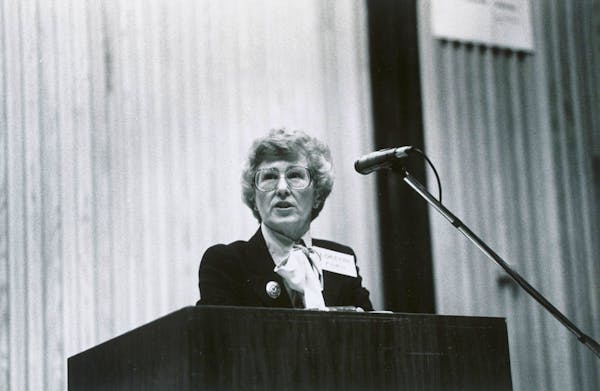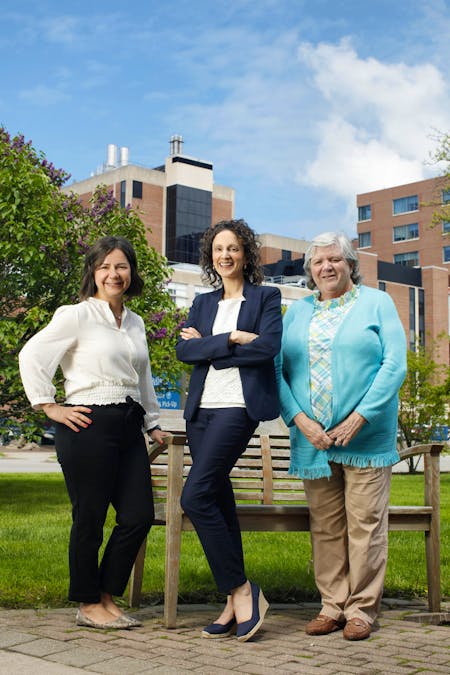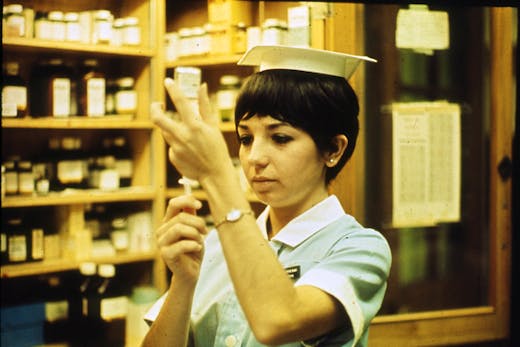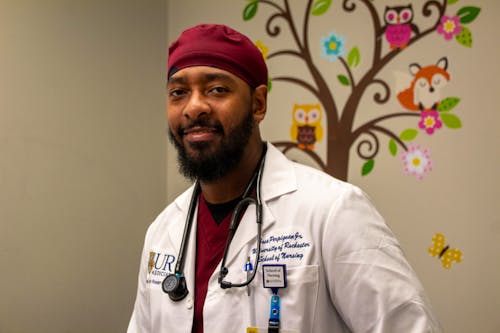UR Nursing Helped Shape the Nurse Practitioner Role. Today, It's America's Fastest-Growing Job.
By Gianluca D'Elia
Tuesday, July 9, 2024

In the mountainous, woodland towns of rural Boulder County, Colorado, Loretta C. Ford, EdD, RN, PNP, FAAN, FAANP, had an important realization about her work as a public health nurse. Often working independently, Ford would make house calls to children and families who might not have seen a provider otherwise, visit nursing homes, collect statistics, and even test the water quality in local wells.
The more her role grew, the more she noticed how nurses could help address deficits in care if they were given more specialized training and decision-making power. Alongside pediatrician Henry Silver, MD, she would go on to co-found the nation’s first pediatric nurse practitioner program at the University of Colorado in 1965 — forever changing the practice and study of nursing.
The nurse practitioner (NP) title added a sense of legitimacy to the duties that Ford already knew nurses could perform, both independently and as collaborators on health care teams.
“We were the ‘Lone Rangers.’ We had to make decisions,” Ford once said in an interview with CNN. These words resonate with many University of Rochester School of Nursing alumni who have joined the NP profession.
Michael Hasselberg, ’07N (MS), ’13N (PhD), remembers starting his first NP role in a rural Finger Lakes village where nearly everyone knew each other, and patients felt a deep sense of gratitude for his presence in the community. Without him, access to specialty care was sparse. By title, he was a psychiatric NP fresh out of his master’s program at the University of Rochester, but both Hasselberg and his patients knew that didn’t capture the full extent of his role: Practicing autonomously, he set up a psychopharmacology clinic, made visits to jails and nursing homes, and served as the only psychiatric provider for six counties.
“It was probably the best thing that ever happened to me in my career,” recalled Hasselberg, whose rural experiences continue to shape his work today as University of Rochester Medical Center’s (URMC) chief digital health officer. “The disparities in rural communities struck me, and ended up becoming my ‘why’ for the rest of my career.”
The demand for NPs is growing rapidly, and not just in rural areas. Today, the nurse practitioner role ranks No. 1 in U.S. News & World Report’s 100 Best Jobs List, and rivals only wind turbine technicians as the nation’s fastest-growing occupation. Patients are more likely than ever to receive care from NPs and physician assistants in nearly every type of health care setting. And in 27 states, NPs have full practice authority, allowing them to open independent practices.
Today, many nurses see the NP role as a pathway to maximize their impact on patients, practice with greater authority, and grow as health care leaders.
“One of the most unique opportunities NPs have is that they get the training and experience of being a registered nurse on the frontlines of care, and then they can take it to a whole new level, functioning similarly to our partner disciplines like medicine, physical therapy, or psychology,” Hasselberg said.
 This is one of the many qualities that draws nurses to the role, said Cheryl Lustik, DNP, RN, MS, APN-C, chief advanced-practice officer at the Margaret D. Sovie Center for Advanced Practice at URMC. She oversees professional development opportunities and senior leadership representation for more than 1,000 nurse practitioners and physician assistants — collectively known as advanced practice providers (APPs).
This is one of the many qualities that draws nurses to the role, said Cheryl Lustik, DNP, RN, MS, APN-C, chief advanced-practice officer at the Margaret D. Sovie Center for Advanced Practice at URMC. She oversees professional development opportunities and senior leadership representation for more than 1,000 nurse practitioners and physician assistants — collectively known as advanced practice providers (APPs).
The Sovie Center promotes a culture of continuous education, in which APPs “have options for career advancement and opportunities for additional education, training, mentorship, or skill development, which hopefully helps them feel more satisfied in their specific role,” Lustik said. URMC hires about 100 APPs per year, Lustik said. That investment in non-physician providers has a significant community impact.
“When we support professional growth for APPs within our organization, it enhances our patients’ care,” Lustik said. “Providers are growing their knowledge and skills, which ultimately means that they can take care of more complex patients.”
This can lead to increased access to care and better patient outcomes and satisfaction overall.
A home to many firsts
With the number of NPs in the U.S. expected to grow by 45 percent over the next decade, it may be hard to believe now that Loretta Ford’s pioneering ideas weren’t fully embraced 60 years ago.
When she joined the UR School of Nursing as its inaugural dean in 1972, she spent years pushing for national and state recognition of the NP role, even testifying to Congress to advocate for more financial and educational support for non-physician health care providers.
“Introductions of new roles into health care systems may shake things up a bit,” she told the U.S. House Subcommittee on Health and the Environment in 1976. “There is a need to change the organizations and structures by which health care is delivered so that the system of care is so well-articulated between and among units, that the training and skills of all health professionals are wisely utilized in team relationships to serve people.
Ford’s advocacy helped pave the way for the University to shape the profession and become an early leader in the NP movement.

In the 1970s, the School’s Family Health Nurse Clinician Program became one of the only master’s programs in the country to prepare nurse practitioners in primary care. And in 1989, the School of Nursing launched the nation’s first Acute Care NP program, just a year after New York passed landmark legislation to authorize NPs' title and scope of practice. The role itself was developed by nurses in Strong’s surgical nursing unit. Graduates of the new master’s program would be able to use the newly state-legislated title of “nurse practitioner.”
The School continues its long tradition of proactively addressing emerging needs in health care today. It was among the first 50 nursing schools to introduce a Doctor of Nursing practice program, as part of a national effort led by the the American Association of Colleges of Nursing (AACN) to prepare advanced practice nurses for clinical leadership roles and improve health care safety and quality.
In 2021, UR Nursing launched New York’s first pediatric acute care NP certificate, which prepares NPs to care for children of all ages with complex, acute, critical and chronic illnesses, disabilities, or injuries. Julie Gottfried, DNP, RN, CNS, CPNP-AC/PC, co-founder and specialty director for the certificate program, said she is confident in NPs’ ability to improve access to care for vulnerable populations.
“The role of the nurse practitioner is integral in addressing health disparities in our society today,” said Gottfried, who has worked with children in both primary care and hospital settings.
In part, she credits this ability to nurses’ holistic approach to care.
“In the provider role, I’m able to pull together the pieces, look into the community I serve, and find local sources of specialized care. I consider how I can help my patient — who, for example, may or may not have transportation to get to various appointments — access the resources that are right there in the community.”
Creating an equitable future
Researchers from the University of Rochester School of Nursing were among the first to quantify the impact of NPs in improving primary care capacity. A 2019 study showed that the growing supply of NPs offset a low supply of physicians in underserved communities across the U.S.
“This has great implications,” said Ying Xue, DNSc, RN, a nursing workforce expert and Loretta C. Ford Endowed Professor in Primary Care Nursing. “Having NPs present in areas with low access to health care addresses big obstacles. Filling the gap regarding access to health care providers can eventually address health disparities.”
A strong focus on health equity remains at the core of NPs’ work at the University of Rochester today, and opportunities to make direct impacts and implement positive changes are motivating future generations of nurses to pursue the NP profession.
Jose Perpignan Jr. ’16N ’24N (MS) dreamed of working in a role where he could bridge the gap between underserved communities and quality care since he was a child, when he watched his father volunteering in their Brooklyn, New York neighborhood as part of a volunteer ambulance service.
“I’ve seen what it looks like when you pour into the community you’re from, and when you don’t have to be a victim of not having the care you should receive,” said Perpignan, who earned his Family NP master’s degree in the spring.

As a bachelor’s student, he supported his mother through a diagnosis with soft tissue sarcoma. The first provider she visited told her that she’d have to have her leg amputated, but that couldn’t have been the only option, he remembered thinking. Upon seeking a second opinion, Perpignan’s mother was told that she’d soon be able to run around and dance with her grandchildren.
“This also motivated me to want to become an NP,” he said. “I wanted to be in a position where I could educate myself, learn, grow, and be able to provide the care and treatment that patients need.”
Susan Blaakman, PhD, RN, PMHNP-BC, FNAP, FAAN, has seen positive, nurse-led changes firsthand as a longtime faculty member and director of UR Nursing’s Psychiatric Mental Health NP program.
One of UR Nursing’s latest NP-led initiatives, the grant-funded Project ENACT (Educating NPs to Address Childhood Trauma), has helped expand the behavioral health workforce serving at-risk children and adolescents. It has trained 70 NPs since its launch and added 18 new clinical sites where students could put the program’s trauma-informed care curriculum into practice.
Project ENACT, which is supported by the Health Resources and Services Administration (HRSA), couldn’t have come at a better time: adolescents’ socioemotional development was disrupted by the COVID-19 pandemic, and they have faced higher rates of depression, anxiety, and suicidal behavior. Paired with a shortage of mental health workers, especially in low-income areas and communities of color, the need is urgent.
“Health equity is really about bringing services to the most vulnerable in our communities, particularly folks that are historically marginalized, and have experienced systemic racism and discrimination. If you have a mental illness, that can sometimes add its own marginalization,” Blaakman said.
Similar strides have been made across several specialty areas at UR Nursing and URMC. Most recently, the University’s Highland Family Medicine Family Nurse Practitioner Residency Program received a $2.4 million HRSA grant to support continued training of more Family Nurse Practitioners to practice in underserved settings and help meet the needs of culturally diverse and clinically complex patients.
385,000 strong
NPs will continue to make a positive impact on many issues health care faces today, such as physician shortages in primary care and specialty practices, the country’s rapidly aging population and its demand for health care services, and care access overall, said Cheryl Lustik, of the Sovie Center for Advanced Practice.
“It's exciting to say that this group of health care providers can help improve access and health outcomes, and that they're leveraged in a way in which they really are looked at as providers, and respected both by the patients and with the physicians that they're working with.”
In the past year, the profession grew by 8.5 percent to 385,000 NPs.
Many NPs are inspired by Loretta Ford herself, who said in her 1972 installation speech that together, “we will create a new order of things” at the School of Nursing.
“What I have tried to do in my role as a nurse practitioner is to push the envelope, and maybe raise the ceiling, similar to Dr. Ford’s vision of what we as NPs could do for patients,” said Heather Wensley ’11N (MS), ’24N (DNP), a nurse practitioner on Golisano Children’s Hospital’s Adolescent Medicine team who specializes in gender health and eating disorders.
“Our work is important within the walls of the clinic, but it’s also important out in the community,” she said, emphasizing NPs’ ability to advocate for change.
When Ford was first considering whether to move to Rochester and take the School of Nursing dean position, she was felt encouraged by URMC’s “hope for the future” of the nursing profession and respect for interprofessional collaboration, she said in a Summer 2023 interview in her Florida home. Throughout its history, the School built a solid foundation as an institution that was ahead of the times, and looking ahead, she said, and it will continue to be both an agent and acceptor of change.
"I think the University of Rochester School of Nursing is well positioned to take the future on, and to create the future that we really need for this nation,” Ford said. “I expect great things to continue at Rochester."
Categories: Outcomes, Nurse Practitioner Programs, Alumni

